Making Powder Metal Bullets
Corbin has temporarily discontinued the offer of EZ-FLOW(tm) tungsten powder with 1% accra-wax coating on the grains, due to the high current price for tungsten. We provide Atomized Copper powder with 0.25% lithium stearate. The grain coatings help the materials flow smoothly without bridging and hanging up in powder dispensers, in funnels, or in drop tubes, reduce the drag and tendancy of the materials to "grab" the walls of their containers or dies under pressure, and finally, aid in allowing the microscopic "dust" to smoothly slide into close position and bind together under high pressure.
Until the recent market changes, Powdered tungsten was available from Corbin in 7000 grain, 35000 grain, and 70000 grain dispenser flasks. It may be offered again once the market stabilizes. EZ Pour Tungsten pours easily through a spout, and can be measured by weight or by volume. Powdered copper is available from Corbin in 1/2 pound, 4 pound, and 100 pound size containers. Three ways to measure powdered metals by volume are:
- Use a powder measure
- Use a powder dipper
- Use the cookie cutter method
The powdered metal will compress from 25 to 50 percent of its height under pressure, so you will want to either pre-swage the metal into a pellet and then put it into the jacket, design your bullet so that the jacket holds the loose powder entirely before swaging, or use a special thin-walled funnel that can guide the powder as a high column that extends beyond the jacket prior to swaging. (See press release about Corbin's funnel dies for powder metal bullet making.)
If you are using Corbin's Atomized Copper powder, you can swage bullets directly in the die without using a jacket, or you can pre-swage a copper core in a solid "core seating" type of die that is actually made in the diameter for a core swage (resulting pellet fits into the jacket, if one is to be used). However, the powder funnel with precision spout that matches the jacket wall thickness, and provides a straight path for the extra-long core seating punch for the powder column, will not work without the proper jacket in place. In that case, we suggest a custom die that has been machined to precisely align an extension section having a funnel-like bowl machined into the top. This extension fits on top of the core seating die, and allows the powder to stack up in a long column, which is then compressed into the lower portion of the die (normal length). The extension is then removed, and the bullet is ejected.
Swaged powder usually will not bond together with additional loose powder. Adding more after swaging it usually results in two separate pellets that only appear to be one, but break apart easily. This may not be a problem with some designs (fragmenting, defense, or target bullets). In that case, you can add two separate "shots" of powder, swaging the first one down and then the second on top.
However, if you must have the powder as one solid pellet after swaging, then the amount of powder initially compressed has to be the final weight desired in the pellet. To get it all into the jacket (assuming you are using a design that requires a jacket), you can preswage the pellet (or "core", as it would be called for bullet making purposes) in a smaller diameter die. This die can be a regular "core seating" die, without bleed holes (as the powder would tend to blow out the holes). However, it would need to have a hole size ("bore" or caliber) which would make a small enough core to fit inside the desired jacket.
Jackets for a .30 caliber, for instance, could have a wall thickness from .015 to .035 inches thick (typical). Not only that, but they could taper in thickness from the mouth to the base. The solid core needs to be small enough so it fits all the way to the bottom of your selected jacket. This means that before you decide on a core seating die to make the powder metal pellet, you have to decide on a source of jackets and use them to determine the pellet diameter required.
So, the first step is to decide upon a jacket. Making your own jacket from copper tubing is the most secure and versatile way to obtain bullet jackets today. You are independent of any manufacturers other than copper tube mills, of which over 200 operate in North America today. Tubing is used in such a wide range of applications, from air conditioners to power plants, from automobiles to steam boilers, that the chances of it becoming hard to find are extremely rare (provided you know where to look). Corbin supplies copper tubing in deep drawing grades, with high precision tolerances designed for jacket making, in all sizes from 1/4-inch diameter to 1/2-inch diameter. All standard calibers from the .224 to the .50 BMG can be made from this range, in just four sizes.
Tubing is available from Corbin in 1/4-inch, 5/16-inch, 3/8-inch, and 1/2-inch diameters with a typical wall thickness of .035 inches. Experience has proven this wall thickness offers the best combination of big game hunting and precision target shooting characteristics, when combined with other techniques to enhance either the strength or increase the expansion.
Corbin's tubing is a semi-hard drawn seamless lead-free copper available in two forms:
- Three-foot lengths, priced by the piece, or...
- Cut to specific jacket-making lengths, by the piece (250 piece minimum).
There are several ways to cut your own pieces of tubing to length before forming them into jackets (which rolls over one end and flattens it, or makes a rebated boattail if you wish). In order of desirability and quality of cut, these are:
- A lathe with air feed, automatic collet closer, tail-stock stop, and special cut-off blade (our method).
- A lathe with manual collet closer, depth stop and special cut-off blade.
- A tubing cutter saw.
- A miter box saw with a special carbide blade.
- A power bandsaw, hacksaw, or table saw with plastic or aluminum or plywood blade.
- A hand saw.
The blade used to cut copper needs to have either a flat rake angle or even a reverse rake, and should have enough teeth per inch so that there are two or more teeth in the copper walls at all times. Special blades with proper rake and set for aluminum, plastic and copper are available for most power saws. Normal blades tend to grab, tear, and smear the copper because they plug up quickly with the soft, "sticky" chips. Copper tube will usually try to rotate when the teeth dig into it, so it needs to be held firmly against a fence or guide, or even clamped with a soft-jaw or contour-machined quick-clamp device while cutting. Most people have built their own additions to conventional saws to create accurate length stops and hold-down clamps. A standard tubing cutter will roll the copper so badly that it won't fit over the punches, and it is too slow and inaccurate.
Once the copper tubing is cut to length, it is processed through a series of steps in one of Corbin's CTJM-1 tubing jacket makers. This rounds one end, draws the tube to exact size, flattens or boattails the end, and thus produces a "drawn-over-mandrel" precision jacket that is hard to tell from a factory jacket, except it is normally more effective for the purpose (since you build it exactly to desired length and style).
With the jacket source secured, you are ready to work on the filling or core. The ID of the final jacket will be somewhat different than the theoretical dimension, depending on variables such as jacket compression and plastic flow. You may be able to guess by simply subtracting twice the jacket wall thickness from the caliber, but it usually is off by several thousandths. The only sure way to know the proper core size is to make some jackets and measure them.
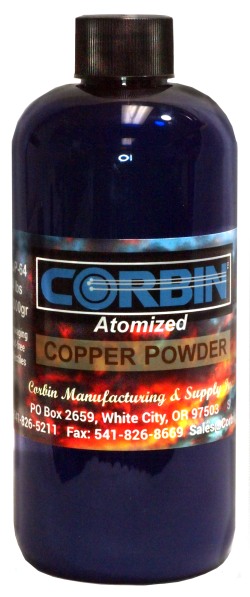
Atomized copper is available in 8-oz, 64-oz, and 100-lb packages from Corbin.
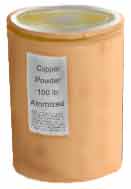 Copper powder is not abrasive and may be swaged directly in the die under 20,000 psi or more. The resulting "green" or unsintered compressed powder bullet should have bright copper color and look like solid copper that has been polished. However, it is usually not strong enough to be fired directly from the gun. The swaged copper powder core can be "sintered" by placing it in an oven and heating until the temperature reaches 900-1000 degrees F, which tends to fuse the edges of the copper grains without actually melting the copper powder. After cooling, the slug can then be reswaged to restore diameter or reshape the ogive. Copper powder can also be mixed with tin or tungsten, or both, to achieve various densities. Tungsten powder should be used within a jacket to protect the swage die from the very hard grains.
Copper powder is not abrasive and may be swaged directly in the die under 20,000 psi or more. The resulting "green" or unsintered compressed powder bullet should have bright copper color and look like solid copper that has been polished. However, it is usually not strong enough to be fired directly from the gun. The swaged copper powder core can be "sintered" by placing it in an oven and heating until the temperature reaches 900-1000 degrees F, which tends to fuse the edges of the copper grains without actually melting the copper powder. After cooling, the slug can then be reswaged to restore diameter or reshape the ogive. Copper powder can also be mixed with tin or tungsten, or both, to achieve various densities. Tungsten powder should be used within a jacket to protect the swage die from the very hard grains.
|
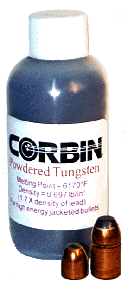
Corbin can provide powdered metal measure/dispensers mounted on quick-adjustable arms, for any of our presses. Shown below is a measure mounted on the CHP-1 Hydro Press.
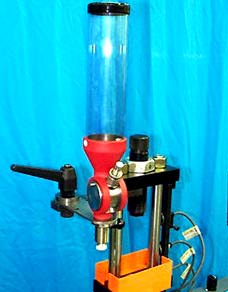
Corbin powdered metals are sold in 2-fluid-ounce or 8-fluid-ounce containers with dispenser caps. Actual weight of the metal will vary with its density. For example, the 2-fluid-ounce container of tungsten weighs one pound, whereas the 2-fluid-ounce container of copper would weigh about 8 ounces. Larger quantities are also available.
Corbin offers atomized copper powder in 8-oz, 64-oz (4-lb), 100-lb, and 500-lb containers. The copper is about 45 micron irregular particles, around 84% less than 45 micron or -325 sieve, and about 14% between 45 and 100 microns. This distribution and size helps lock the powder together with high green strength when swaged without sintering. The powder is lightly lubricated with 0.25% lithium stearate, which helps prevent sticking in the dies and aids in the flow of powder. It also helps transfer the pressure through the powder so that it compresses with lower pressure. Typical pressure for a pressed copper powder bullet would be about 20,000 psi to 30,000 psi. Copper powder is often used in mixture with tungsten, inside a bullet jacket, for fragmenting non-ricochet indoor target bullets that are non-toxic (as compared to lead). Prices for copper powder are on the PRICE LIST.
Corbin also offers pure molybdenum disulfide (dry lubricant) powder in the 2-ounce or 8-ounce (volume) bottles with dispensers. This substance is used to coat bullets. It can be rolled or tumbled onto the surface of a bullet that has not quite been swaged to full diameter (formed in a core seat die but not yet point formed in the final die). Then, the lubricated cylinder can be swaged to final (expanded) diameter, which pushes the lubricant into the surface of the bullet. A quick-drying spray-on hard film of molybdenum disulfide can be applied with Corbin's 11-oz aerosol lube, MSL-11. The spray is applied to lead bullet in one or two light layers, which dry almost instantly to form a clean, hard film on the bullet.
Corbin stocks certain popular powders for swaging lead-free PM bullets (Powdered Metal). While price per pound is usually more than for lead wire, the benefits of making non-toxic bullets and the possibility of eliminating the jacket can more than compensate for the material cost.
|
Powdered metal comparison:
|
BISMUTH
Bi
|
Melts: 271.3 deg.C.
Density: 9.8 gm/cc
Hardness: 2.5 Mohs
|
BRONZE
Cu 80%, Zn 20%
|
Melts: 930 deg.C.
Density: 8.47 gm/cc
Hardness: 4.0 Mohs
|
COPPER
Cu
|
Melts: 1083 deg.C.
Density: 8.94 gm/cc
Hardness: 3.0 Mohs
|
LEAD
Pb
|
Melts: 327.43 deg.C.
Density: 11.34 gm/cc
Hardness: 1.5 Mohs
|
MOLYBDENUM
Mo
|
Melts: 2610 deg.C.
Density: 10.22 gm/cc
Hardness: 1.2 Mohs
|
MOLYBDENUM
DISULFIDE
MoS(2)
|
Melts: 1185 deg.C.
Density: 4.08 gm/cc
Hardness: .5 Mohs
|
TIN
Sn
|
Melts: 231.9 deg.C.
Density: 7.29 gm/cc
Hardness: 2 Mohs
|
TUNGSTEN
W
|
Melts: 3387 deg.C.
Density: 19.3 gm/cc
Hardness: 8.9 Mohs
|
ZINC
Zn
|
Melts: 419.5 deg.C.
Density: 7.133 gm/cc
Hardness: 2.5 Mohs
|
Mohs Hardness Index
- 0 - Mercury
- 0.5 - Molybdenum disulfide
- 1 - Talc
- 1.2 - Molybdenum
- 2 - Gypsum, Tin
- 2.5 - Zinc, Gold, Bismuth
- 3 - Calcite, Copper
- 4 - Silver, Bronze
- 6 - Orthoclase
- 7 - Quartz
- 8 - Topaz
- 8.9 - Tungsten
- 9 - Corundum
- 9.2 - Tungsten Carbide
- 9.5 - Borazon
- 10 - Diamond
|
|
Knowing the proper jacket ID means you can determine the size of the core to fit inside. The core should slip easily into the jacket, so it can be anywhere from 0.002 to 0.010 inches smaller than the ID of the jacket. For instance, a typical .308 tubing jacket might have an ID of 0.235 inches, which means that the pellet or core could be from 0.233 to as little as 0.223 inches in diameter. It cannot be the same size, because even if you could force it in, air might be trapped inside like a pistol and cylinder.
With the correct size of core seating die, you can either dipper or measure a charge of powder metal and put it into the die directly. Using a firm pressure of about 30,000 psi inside the die (gage pressure is far lower, depending on the caliber: use the book POWER SWAGING to look up the proper and safe limit for a given caliber), you can form some powders (such as a tin and tungsten mix, or a bismuth/tin/copper mix) into a solid that will stand handling outside of the die. With pure tungsten, the metal will not stick together but requires a binder. Binders can be stearic acid, tin, nylon powder, bismuth, or combinations of these. Each person developing a powder metal bullet usually has their own experimentally developed binder combination for desired results. The amounts and grain sizes will determine the strength and density of the finished pellet.
If you want to swage the material directly into the jacket then you can use a special thin-walled powder funnel developed by Corbin for each caliber and wall thickness of jacket, to drop the powder from a measure or scale pan directly into the jacket and also to guide the seating punch down into the jacket, with the funnel in place.
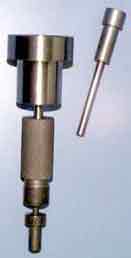 These funnels are custom made for the caliber and column height of material to be used in your bullet design. They are not inexpensive, but they solve the problem of compacting loose powder into a jacket that would be too short for the initial column height. They are machined from steel and given a high finish, with a special complex curved ID to move powders rapidly into the column. They can be made for any caliber from .14 to .50 BMG. The "spout" of the funnel is the same thickness as the jacket you plan to use, so it mates with the edge of the jacket. The length is also adjusted so it will work with the shortest jacket you plan to use (longer jackets simply raise the funnel up).
These funnels are custom made for the caliber and column height of material to be used in your bullet design. They are not inexpensive, but they solve the problem of compacting loose powder into a jacket that would be too short for the initial column height. They are machined from steel and given a high finish, with a special complex curved ID to move powders rapidly into the column. They can be made for any caliber from .14 to .50 BMG. The "spout" of the funnel is the same thickness as the jacket you plan to use, so it mates with the edge of the jacket. The length is also adjusted so it will work with the shortest jacket you plan to use (longer jackets simply raise the funnel up).
Such steel funnels are somewhat fragile, and must be stored and handled with care. Dropping the funnel onto a concrete floor can destroy the fit of the spout to the die and jacket, for instance. The ID of the funnel is made so that your powder seating punch is an exact fit. It cannot be used with other punches or different jacket diameters (at least, not for columns of powder taller than the jacket length).
Once the powder is compacted into the jacket, the bullet is processed like any other (point is formed in the PF die). In the case of a rebated boattail, where two dies are used in sequence to form the base, the process may be slightly different. The powder may need to be lightly compacted with the funnel, then the funnel removed and a special shoulder punch used to finish the seating. The boattail angle can force the jacket material to flow forward under seating pressure, so that the closed base opens on a tubing jacket. By using a shoulder on the seating punch, which contacts the open end of the jacket, the jacket cannot move forward, and the base remains closed.
Powder metals can be "sintered" by heating to a critical temperature after they are swaged into a pellet. This is the usual way of forming a solid from tungsten and other powder metals. The temperature of heating is controlled to obtain the desired matrix in the pellet. Armour piercing anti-tank projectiles have been made from tungsten/nickel powder mixes in this manner. But it is a technology that anyone can apply, using one of Corbin's small digital-control electric heat treatment ovens, such as the HTO-2 with a 4 by 5 by 6 inch cavity size. This typically handles a batch of 100 to 300 bullets.
Small cavity size is desirable for fast cycle time, so you must balance the number of bullets you wish to process at one time, with the amount of time (and cost) of heating and cooling a larger oven. The temperatures typically are in the 1,000 to 1,400 degree range. The kind of material used in the oven also determines its cycle rate. Light, thermally efficient ceramics are used in Corbin's oven, so you can bring one to full temperature in fifteen minutes. Kilns and other big ovens often use high density brick as liners, which can take hours to reach proper temperature and cool down again. Large ovens also usually require special wiring and 240 volt circuitry, whereas Corbins light-weight ovens plug into any USA standard 15-amp 110-115 volt household outlet (export models for 240 volt 50Hz are available).
Powder metal bullets may or may not need to be sintered, depending on the application. If you wish to swage them without a jacket, then the mixture you use will determine whether sintering is desireable or required. A mixture of half tin and half tungsten, or a copper/tin/bismuth mixture, often will stick together so well that you don't need to do anything except lubricate it by rolling or swaging a thin coating of molybdenum disulfide powder onto the surface. Corbin also provides moly powder in 2-oz, 8-oz, and 16-oz quantities (by volume, fluid measure).
|
Powdered metal bullets have been around since long before World War II. Most of the technology for making tungsten/tin/cobalt and other metal powders is well known from the days before modern tungsten carbide and titanium carbide coated tool bits were developed, since sintered tungsten powder metal tools were one of the first uses of this hard metal, with long-expired patents providing information in hard copy that has not yet been converted to electronic format by the US Patent Office.
However, three factors today have brought about renewed interest in PM bullets:
- Environmental concerns about range contamination from lead.
- The increasing cost and decreasing availability of conventional bullet jackets.
- The tremendous growth of home and small business swaging systems, which can easily handle powdered metal forming techniques.
Corbin has been working with government agencies, contractors, and independent developers for many years in the powder metal swaged bullet field, and is providing support, machinery, and dies for the vast majority of experimenters and developers in this field. We do not compete with our clients: any proprietary or "trade secret" processes or mixtures are the property and responsibility of those who developed them, unless prior art or coincidental development has occurred. At the same time, we need to know the current state of the art in order to support our bullet-maker clients, so we develop processes and mixtures, tooling and techniques constantly, as we have for the past decade. Any information we develop as a result of our work alone, is freely made available to all our clients who wish to inquire about it. But specific work done for a particular client is guarded information. Inevitably there are cross-overs, where we have independently developed ideas and tried processes which are similar to those some of our clients wish to keep secret. Therefore, we offer these suggestions:
- If you have a product idea which you wish to develop secretly, discuss it fully with Corbin before proceeding, to determine if any part of your idea has already been done. If so, that part cannot be kept secret, and may in fact have already been published. Agree in advance on which specific features or procedures are unique and have not been tried before. Those can be protected, so long as no one else independently develops the same idea (it happens frequently, because good ideas are often obvious to people who study a problem carefully).
- Base your business plan on good marketing instead of protecting secrets. It is far too easy to spend huge amounts of money to obtain a patent that, in spite of its apparent validity, could be made moot by undiscovered prior art (in this field, it has probably been done before at a time when economics did not favor a business based upon the idea). Having a current patent issued does not necessarily mean it cannot be successfully defeated by pointing out very early prior patents which did not turn up on an electronic search because they were not yet converted to electronic format.
- The person who enters the field first, with the best marketing and promotion, and the best value (not the same as lowest price) will win most of the market. A few competitors with copies seldom cause any serious harm, and can even serve to help spread the word about the basic idea. A person who enters the market later can only take a significant share if he has a better value to offer, or makes it seem that way with better promotion and advertising. Of course, if you are entering later, you can win market share against a competitor who is too complacent or who relies entirely upon a patentable idea, because significant improvements are fairly easy to prove (how much more accurate, precise, or deadly does a bullet have to be to be significantly improved?) and modifications to existing design that advance the art are not difficult to devise.
PRIVACY POLICIES
|





 Technology Since 1975
Technology Since 1975
 Call (541) 826-5211, 9AM-5PM Mon-Thurs
Call (541) 826-5211, 9AM-5PM Mon-Thurs